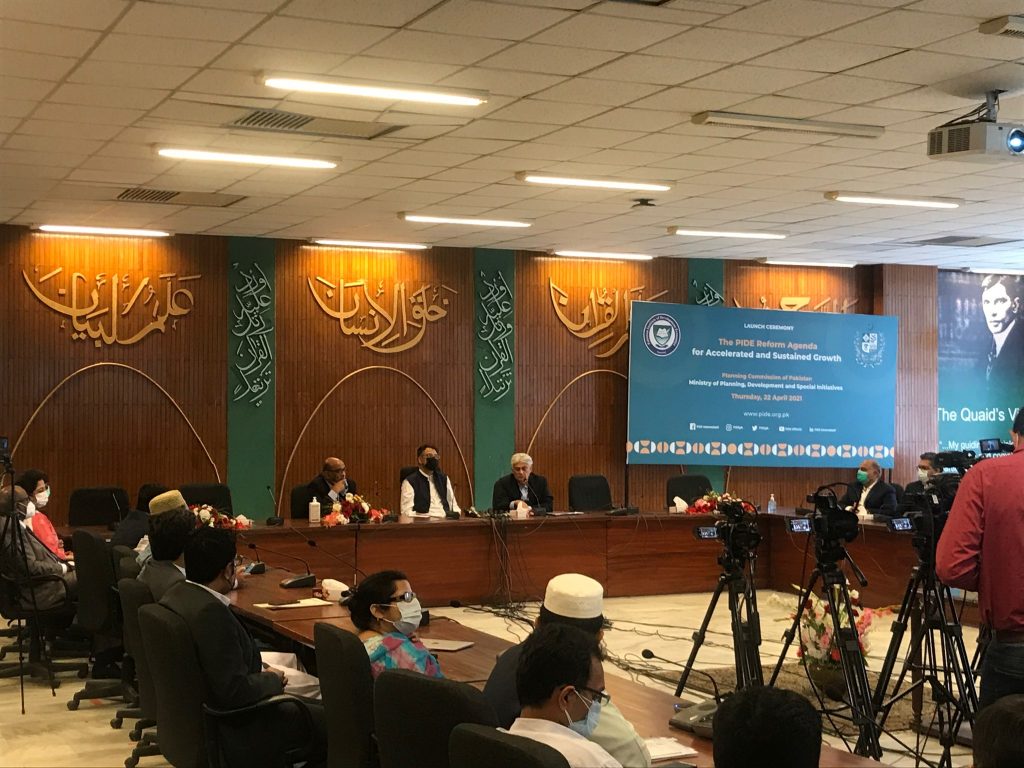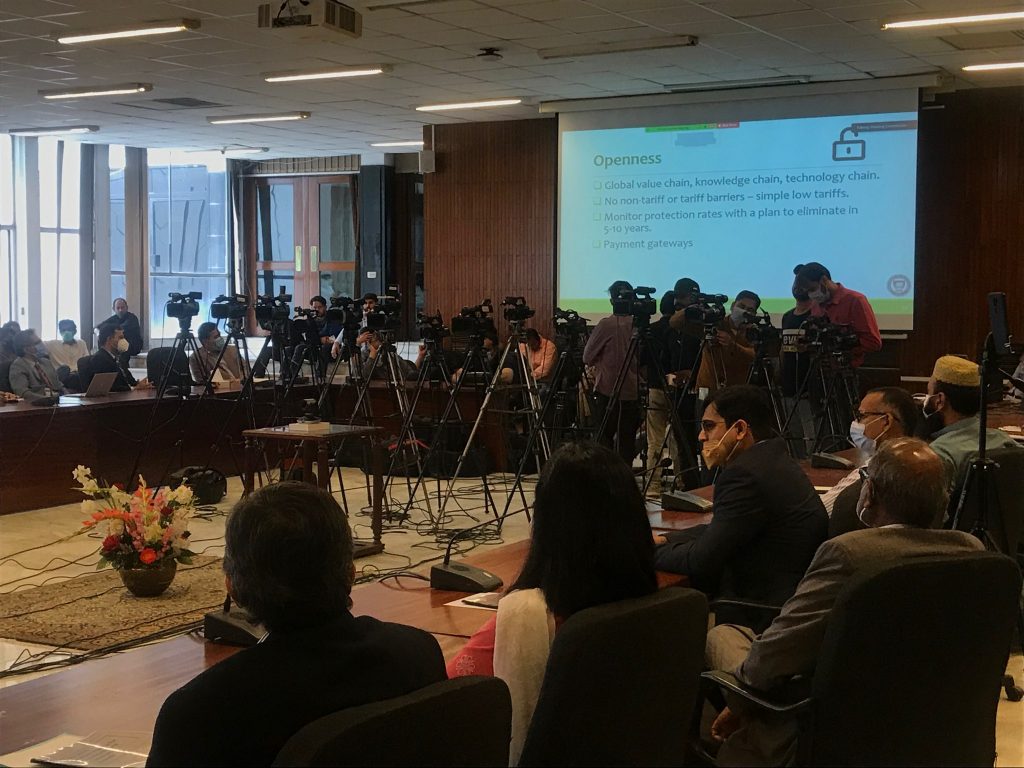The PIDE Reform Agenda for Accelerated and Sustained growth was launched today at the Planning Commission of Pakistan. Dr. Nadeem Ul Haque Vice-Chancellor, PIDE presented the Agenda at the launch ceremony attended by many well-known economists, development practitioners, representatives from universities, development partners, and several ministries. Minister of Planning Development and Special Initiatives, Mr. Asad Umar was the chief guest at the launch event.
3 Tiny Stocks Primed to Explode
The world's greatest investor — Warren Buffett — has a simple formula for making big money in the markets. He buys up valuable assets when they are very cheap. For stock market investors that means buying up cheap small cap stocks like these with huge upside potential.
We've set up an alert service to help smart investors take full advantage of the small cap stocks primed for big returns.
Click here for full details and to join for free
Sponsored
Sustainable economic growth requires improvement in energy productivity-invest inenergy innovations, distributed generation and smart energy solution, says @nadeemhaque #ReformAgenda for accelerated & #SustainedGrowth@durre_nayab_ @Asad_Umar
— Pakistan Institute of Development Economics (PIDE) (@PIDEpk) April 22, 2021
Watch live https://t.co/z209cHxJ20 pic.twitter.com/HbcYGM0piI
According to PIDE the task of preparing the Reform Agenda began with asking a central question; Can Pakistan experience accelerated and sustained economic growth and If yes, how? To find an answer VC PIDE constituted a PIDE Growth Commission. The Commission comprised renowned local economists and development practitioners from all over the country. The commission also had an adequate representation of the female professionals. The commission was supported by a secretariat at PIDE, consisting of 18 researchers led by Dr. Nadeem Ul Haque, Vice-Chancellor PIDE.
Government must put in significant effort and resources to build competitive market, @nadeemhaque #ReformAgenda for accelerated & #SustainedGrowth @durre_nayab_ @Asad_Umar
— Pakistan Institute of Development Economics (PIDE) (@PIDEpk) April 22, 2021
Watch live https://t.co/z209cHxJ20 pic.twitter.com/0CsVgUwEwv
The first step involved developing a slide deck that depicted the structural issues that constrain growth in Pakistan and the measures required to alleviate these constraints. This slide deck was discussed and modified extensively in several meetings of the PIDE Growth Commission. Next, the secretariat at PIDE drafted the outline and initiated writing the Reform Agenda based on the outline. The drafts of sections and chapters moved back and forth between the PIDE staff and the Vice-Chancellor till the first draft of the complete Reform Agenda stood completed. At this stage, PIDE’s research staff interacted individually with commission members and other practitioners in government and the private sector and incorporated their suggestions.

The Commission met several times to discuss and debate each aspect of the Growth Reform Agenda. The points on which consensus could not be achieved were taken off the report while others were added. The final Growth Reform Agenda reflects the consensus view of the PIDE Growth Commission.

The reform agenda mentions that an increasing labour force is entering the market due to youth bulge. To ensure gainful employment for the labour force entering the market and to sustain the country’s high level of debt the required GDP growth rate is 7-9% per annum. The document takes pain to stress that this is the required growth and not a projected rate.
The Agenda takes the view that the development model that Pakistan has been using since the sixties focuses primarily on investment in hardware led by infrastructure. This model, argues the agenda, developed by Dr. Mahbub ul Haq and the then Harvard Advisory group in the ‘60s was correct for those times when the country needed investment infrastructure. However, with change dynamics, now the model needs to undergo a paradigm shift – the country now needs to shift its focus from investment in hardware to investment in the software of the society. This software is the quality human capital, innovation, R & D, and most importantly the laws, rules, and processes that further economic activity.
The Reform Agenda points out that the present laws, rules, and processes constrain the generation of ideas and carrying out overall economic activity. The agenda citing several frictions in carrying out entrepreneurial activity calls for a revamp of the laws and processes that hamper economic activity. The examples of frictions include; 09 procedures are required to get a permit which cost around 9 percent of the construction value, land developers need 22 NOCs from different agencies to proceed with land development, 45 steps are required to lay an optic fiber for internet connectivity and on average, a firm spends 577 hours and wades through 47 procedures to pay the several taxes that it is required to pay. The reform agenda argues that amending laws and processes to significantly reduce these frictions will enormously boost growth by increasing productivity and hence investment – the two key drivers of growth.
Therefore, argues the Agenda, to begin the journey on a high growth trajectory requires a well-functioning state – entire public service including Civil Service, Judiciary, regulatory bodies, and local governments, etc will have to be reformed to deliver.
The agenda stresses that the cities that major economic activity happens in cities that are dense, walkable, and mixed-use. The agenda recommends rethinking our cities to serve as an engine of economic growth.
The agenda stresses that to increases the competitiveness of our goods and services the energy rates must be brought down significantly. In this regard, the agenda recommends several measures to clear the mess that the energy sector faces. These include; decentralization of the sector, making the regulatory authorities like Nepra and Ogra independent enough to take their decisions. The agenda also recommends sufficiently enhancing the capacity of these regulatory authorities by housing these with professionals.
The reform agenda also identifies policy, regulatory, and procedural constraints that inhibit openness to external trade and suggests measures required to increase the degree of openness.
Recognizing that technology and artificial intelligence are disrupting almost every field, the agenda argues for state readiness to embrace technology. Internet access is recognized as a key element of such readiness. The agenda recommends; releasing spectrum, developing a plan to facilitate laying down connectivity fiber, revisiting internet taxation, and exploring subsidizing internet access to students and marginalized segments.









